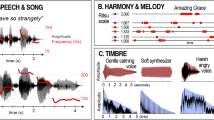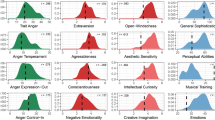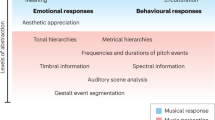Abstract
Music has been shown to have beneficial effects on humans but little is known about the effects of music on nonhuman primates in biomedical research settings. The authors monitored the effects of music on the behavior of captive chimpanzees and found that music had significant positive effects, including a reduction in agitated and aggressive behaviors.
This is a preview of subscription content, access via your institution
Access options
Subscribe to this journal
We are sorry, but there is no personal subscription option available for your country.
Buy this article
- Purchase on Springer Link
- Instant access to full article PDF
Prices may be subject to local taxes which are calculated during checkout


Similar content being viewed by others
References
Christie, M.E. Music therapy applications in a skilled and intermediate care nursing home facility: a clinical study. Activities, Adaptation & Aging 16, 69–87 (1992).
Colligan, K.G. Music therapy and hospice care. Activities, Adaptation & Aging 10, 103–122 (1987).
Lipe, A.W. The use of music therapy as an individual activity. Activities, Adaptation & Aging 10, 93–102 (1987).
Metzger, L.K. A study of the musical preference of psychiatric patients in a short-term treatment center. The Arts in Psychotherapy 18, 357–358 (1991).
Cabrera, I.N. & Lee, M.H. Reducing noise pollution in the hospital setting by establishing a department of sound: a survey of recent research on the effects of noise and music in health care. Prev. Med. 30, 339–345 (2000).
Rosling, L.K. & Kitchen, J. Music and drawing with institutionalized elderly. Activities, Adaptation & Aging 17, 27–38 (1992).
Dawson, P. & Schacter, Y. Using music to decrease aggressive behaviour during bathtime. Perspectives 23, 27–28 (1999).
Knight, W.E. & Rickard, N.S. Relaxing music prevents stress-induced increases in subjective anxiety, systolic blood pressure, and heart rate in healthy males and females. J. Music Ther. 38, 254–272 (2001).
Lou, M.F. The use of music to decrease agitated behaviour of the demented elderly: the state of the science. Scand. J. Caring Sci. 15, 165–173 (2001).
Remington, R. Calming music and hand massage with agitated elderly. Nurs. Res. 51, 317–323 (2002).
Thomas, L.A. Clinical management of stressors perceived by patients on mechanical ventilation. AACN Clin. Issues 14, 73–81 (2003).
Wang, S.M., Kulkarni, L., Doley, J. & Kain, Z.N. Music and preoperative anxiety: a randomized, controlled study. Anesth. Analg. 94, 1489–1494 (2002).
Hilliard, R.E. The effects of music therapy-based bereavement groups on mood and behavior of grieving children: a pilot study. J. Music Ther. 38, 291–306 (2001).
Shealy, C.N., Cady, R.K. & Cox, R.H. Pain, stress, and depression: psychoneurophysiology and therapy. Stress Med. 11, 75–77 (1995).
Bonder, B.R. Psychotherapy for individuals with Alzheimer disease. Alzheimer Dis. Assoc. Disord. 8, 75–81 (1994).
Fauerbach, J.A., Lawrence, J.W., Haythornthwaite, J.A. & Richter, L. Coping with the stress of a painful medical procedure. Behav. Res. Ther. 40, 1003–1015 (2002).
McCaffrey, R.G. & Good, M. The lived experience of listening to music while recovering from surgery. J. Holist. Nurs. 18, 378–390 (2000).
Aitken, J.C., Wilson, S., Coury, D. & Moursi, A.M. The effect of music distraction on pain, anxiety and behavior in pediatric dental patients. Pediatr. Dent. 24, 114–118 (2002).
Vickers, A.J. & Cassileth, B.R. Unconventional therapies for cancer and cancer-related symptoms. Lancet Oncol. 2, 226–232 (2001).
Bright, R. The use of music therapy and activity with demented patients who are deemed difficult to manage. Clin. Gerontol. 6, 131–144 (1987).
Finnema, E., Droes, R.M., Ribbe, M. & Van Tilburg, W. The effects of emotion-oriented approaches in the care for persons suffering from dementia: a review of literature. Int. J. Geriatr. Psychiatry 15, 141–161 (2000).
Blackmore, W.M. in Housing, Care, and Psychological Wellbeing of Captive and Laboratory Primates (ed. Segal, E.F) 235–243 (Noyes Publications, Park Ridge, NJ, 1989).
Fritz, J. & Howell, S. Psychological wellness for captive chimpanzees: an evaluative program. Humane Innovations and Alternatives 7, 426–434 (1993).
Brent, L. & Weaver, D. The physiological and behavioral effects of radio music on singly housed baboons. J. Med. Primatol. 57, 395–421 (1996).
O'Neill, P. in Housing, Care, and Psychological Wellbeing of Captive and Laboratory Primates (ed. Segal, E.F.) 135–160 (Noyes Publications, Park Ridge, NJ, 1989).
Line, S., Markowitz, H., Morgan, K.N. & Strong, S. in Through the Looking Glass: Issues of Psychological Wellbeing in Captive Nonhuman Primates (eds Novak, M.A. & Petto, A.J.) 160–179 (American Psychological Association, Washington, DC, 1991).
Novak, M.A. & Drewson, K.H. in Housing, Care, and Psychological Wellbeing of Captive and Laboratory Primates (ed. Segal, E.F.) 161–182 (Noyes Publications, Park Ridge, NJ, 1989).
Palmer A. Drugs, sex and rock'n roll: HIV/AIDS in adolescents presents a challenge. HIV Clin. 12, 1–4 (2000).
Strasburger, V.C. Is it only rock 'n' roll? The chicken-and-the-egg dilemma. J. Adolesc. Health 23, 1–2 (1998).
Erickson, T.B. et al. Prehospital severity scoring at major rock concert events. Prehospital Disaster Med. 12, 195–199 (1997).
Wann, D.L. & Wilson, A.M. Associations among rock music videos, locus of control, and aggression. Psychol. Rep. 79, 642 (1996).
Erickson, T.B., Aks, S.E., Koenigsberg, M., Bunney, E.B., Schurgin, B. & Levy, P. Drug use patterns at major rock concert events. Ann. Emerg. Med. 28, 22–26 (1996).
Robinson, T.O., Weaver, J.B. & Zillmann, D. Exploring the relation between personality and the appreciation of rock music. Psychol. Rep. 78, 259–269 (1996).
Lempert, T. & Bauer, M. Mass fainting at rock concerts. N. Engl. J. Med. 332, 1721 (1995).
Strasburger, V.C. & Hendren, R.L. Rock music and music videos. Pediatr. Ann. 24, 97–103 (1995).
Kojima, S. Comparison of auditory functions in the chimpanzee and human. Folia Primatol. (Basel). 55, 62–72 (1990).
Institute of Laboratory Animal Resources, National Research Council. Guide for the Care and Use of Laboratory Animals (National Academic Press: Washington, DC, 1996).
Dejoy, D.M. The nonauditory effects of noise: review and perspectives for research. J. Aud. Res. 24, 123–150 (1984).
Acknowledgements
The authors thank the PFA care and research staff, Timothy Russell, Arizona State University Symphony Director, members of the Arizona State University Orchestra, and Stephanie Meredith, our classical music soloist. This study was supported in part by the University of Texas, M.D. Anderson Cancer Center Research Center, subcontract U42 RR 15090-02, within the National Institutes of Health Biomedical Research Program.
Author information
Authors and Affiliations
Corresponding author
Rights and permissions
About this article
Cite this article
Howell, S., Schwandt, M., Fritz, J. et al. A Stereo Music System as Environmental Enrichment for Captive Chimpanzees. Lab Anim 32, 31–36 (2003). https://doi.org/10.1038/laban1103-31
Received:
Accepted:
Issue Date:
DOI: https://doi.org/10.1038/laban1103-31
This article is cited by
-
Music modulates emotional responses in growing pigs
Scientific Reports (2022)
-
The effects of music on animal physiology, behavior and welfare
Lab Animal (2013)
-
Efficacy of auditory enrichment in a prosimian primate (Otolemur garnettii)
Lab Animal (2009)



